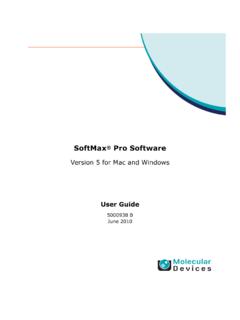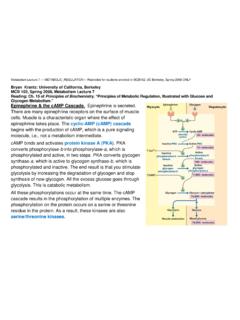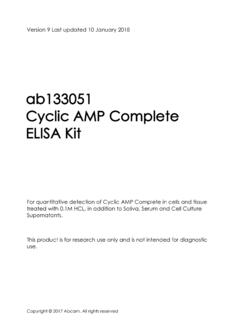Transcription of CatchPoint Cyclic-AMP Fluorescent Assay Kit R8088 …
1 CatchPoint cyclic -cAMP Fluorescent Assay Kit _ 96-well format 1 Product Insert CatchPoint Cyclic-AMP Fluorescent Assay Kit Product # R8088 Quantity: 192, 120 L reactions Introduction About the cAMP Assay The CatchPoint Cyclic-AMP Fluorescent Assay Kit measures levels of 3 , 5 - cyclic adenosine monophosphate (cAMP) or adenylate cyclase activity via a competitive immunoassay for cAMP. The Assay requires only a single washing step, and readings can be taken in as little as 10 minutes or as long as 24 hours following substrate addition, since no termination step is needed. The cAMP Fluorescent Assay Kit is suitable for use in cell-based assays. Principle of the Assay The cAMP in the sample or standard competes with horseradish peroxidase (HRP)-labeled cAMP conjugate for binding sites on the anti-cAMP antibodies (Fig.)
2 1). In the absence of cAMP, most of the HRP-cAMP conjugate is bound to the antibody. Increasing concentrations of cAMP competitively decrease the amount of bound conjugate, thus decreasing measured HRP activity. Figure 1. Principle of the CatchPoint cAMP Assay system HRP cAMP cAMP-HRP Conjugate Rabbit anti-cAMP Goat anti-Rabbit IgG Antibody coated microplate No cAMP Maximum HRP activity Increasing cAMP Decreasing HRP activityHRPHRP HRPHRPHRPHRP HRPHRPHRP CatchPoint cyclic -cAMP Fluorescent Assay Kit _ 96-well format 2 Applications The kit is designed for use in applications where cAMP is generated in biochemical Assay systems, such as assays of adenylate cyclase activity. In addition, this kit can be used for cell-based assays to measure intracellular cAMP levels following treatment with agonists or antagonists to G-protein coupled receptor systems.
3 Materials and Equipment Kit Components The following table lists the kit components. Table 1: The CatchPoint cAMP Fluorescent Assay Kit (P/N R8088 ) contents Reagent Quantity Description 96-well black plate (clear bottom) 2 plates 96-well plate coated with Goat anti-Rabbit IgG. Plates are pre-blocked and ready to use. cAMP Assay Buffer 100 mL cAMP Assay Buffer, pH Rabbit anti-cAMP Antibody 1 vial Antibody, lyophilized cAMP Calibrator 1 vial 30 M cAMP Calibrator, lyophilized. On reconstitution with 5 mL Assay buffer each vial contains 30,000 pmol cAMP / mL. HRP-cAMP Conjugate 1 vial HRP-cAMP Conjugate, lyophilized 10X Wash Concentrate 100 mL 10X Wash Concentrate, pH Cell Lysis Buffer 50 mL Cell Lysis Buffer, pH Stoplight Red Substrate 450 L One vial containing 100X Substrate Substrate Buffer 100 mL Substrate Buffer, pH When the working concentrations of the above reagents are used as suggested, each kit provides sufficient reagents for two 96-well microplates with 120 L total Assay volume.
4 CatchPoint cyclic -cAMP Fluorescent Assay Kit _ 96-well format 3 Storage and Handling All kit components are to be stored at 4 C. IMPORTANT: Allow all the reagents to warm to room temperature prior to use. Note: Small volumes of product will occasionally collect in the cap of the product vial during shipment. Gently tap the vial on a hard surface or briefly centrifuge the vial to collect any liquid trapped in the vial cap. When stored properly, the kit components are stable for six months from the date of receipt. The reconstituted working solutions of Rabbit anti-cAMP, cAMP Calibrator, and HRP-cAMP Conjugate are stable for 3 weeks at 4 C. To insure optimal performance of the reagents do not store below 4 C once reconstituted. If the entire plate will not be used, protect any unused wells with a plate sealer and store at 4 C in the original foil wrapper protected from light.
5 IMPORTANT: The reconstituted substrate solution is sensitive to light. To insure optimal performance we recommend preparing a fresh stock solution (keep protected from light) and adding to the Assay plate within 60 minutes. Following substrate addition readings can be taken at 10 minutes or as long as 24 hours. Materials Required but not Provided The following tables list the materials required but not supplied. Table 2: Reagents and supplies Reagent Item Source 3% wt / vol hydrogen peroxide (H2O2) Major laboratory suppliers (MLS) mL polypropylene capped centrifuge tubes MLS 10 mL capped centrifuge tubes MLS Pipettors adjustable volume MLS Multi-channel troughs MLS Table 3: Compatible Instruments available from Molecular Devices (MDC) Equipment Item Source Analyst System One of the following.
6 - Analyst AD - Analyst HT - Acquest - Screen Station Gemini XS System FlexStation Embla 96/384 Well Washer MDC P/N 42-000-0096 MDC P/N 42-000-0100 MDC P/N 42-000-0102 MDC P/N 42-000-0151 MDC P/N 0200-3940 MDC P/N 0200-4000 MDC P/N 0200-3948 CatchPoint cyclic -cAMP Fluorescent Assay Kit _ 96-well format 4 CatchPoint cAMP Fluorescent Assay Kit Experimental Protocol Preparing the Reagents The following protocol provides sufficient reagents to run one 96-well plate, including 16 calibrators, 2 controls, and up to 78 samples. Table 4: Preparation of reagents Step Action 1 Reconstitute one vial of 30 M cAMP Calibrator: Add 5 mL of cAMP Assay Buffer (pH ) to the vial. Mix well to ensure dissolution of all contents. Store on ice or at 4 C. 2 Reconstitute one vial of HRP-cAMP Conjugate: Add 10 mL of cAMP Assay Buffer (pH ) to one of the vials.
7 Mix well to ensure dissolution of all contents. Store on ice or at 4 C. 3 Reconstitute one vial of Rabbit anti-cAMP Antibody: Add 10 mL of cAMP Assay Buffer (pH ) to one of the vials. Mix well to ensure dissolution of all contents. Store on ice or at 4 C. 4 Dilute 10X Wash Concentrate 10-fold in deionized water, for one Assay plate dilute 50 mL of 10X Wash Concentrate in 450 mL of deionized water.* 5 Prepare calibrators: The 30 M cAMP calibrator is diluted in cAMP Assay Buffer to prepare stock calibrators of 10000, 100, 33, 11, , , and nM cAMP. These give 3300, 33, 11, , , , and nM (400, , , , , , and pmol) final concentrations in the Assay . 1. Add 100 L of the 30 M cAMP calibrator to 200 L of cAMP Assay Buffer. This is the 10,000 nM stock calibrator. 2. Add 10 L of the 10,000 nM stock calibrator to 990 L of cAMP Assay Buffer. This is the 100 nM stock calibrator.
8 3. In cAMP Assay Buffer, serially dilute the 100 nM stock calibrator in a 3-fold fashion five times to produce the 33, 11, , , and nM cAMP stock calibrators. 40 L of each calibrator are required per replicate. Prepare 200 L of each (ample for two replicates). As a 0 nM (zero dose) calibrator, use the cAMP Assay Buffer itself. * On dilution of the 10X Wash Buffer concentrate, the reagent contains M Tris, 150 mM NaCl, Tween 20, and Proclin 200 (pH ). CatchPoint cyclic -cAMP Fluorescent Assay Kit _ 96-well format 5 Preparing the Plate For ease of analysis and calculation, the Assay plate contains the calibrators, controls, and samples as outlined below. Use the suggested template (Table 5) and run the samples in duplicate. Note: The order of addition of each component to the wells and the incubation time are important. Mix samples and all reagents gently but thoroughly before use.
9 All Assay wells will be prepared by dispensing the Assay components in the following order: 1) Calibrator, control, or sample 2) Rabbit anti-cAMP Antibody 3) HRP-cAMP Conjugate Table 5: To prepare the Assay plate: Step Action Designing your Assay plate (plate map): We suggest preparing the plate according to the template below. If you are using SoftMax Pro to analyze your results, you may set up a template before or after reading the plate. If you set up the plate before, you can print out a template to help in preparing your plate. Column Row1 2 3 A 3300 nM 3300 nM Control 1 (400 pmol) (400 pmol) B 33 nM 33 nM Control 2 (4 pmol) (4 pmol) C 11 nM 11 nM ( pmol) ( pmol) D nM nM ( pmol) ( pmol) E nM nM Column 3 (C H) and ( nM) ( nM) all of columns 4 - 12:F nM nM Samples for analysis ( pmol) ( pmol) G nM nM ( pmol) ( pmol) H 0 nM 0 nM (buffer only) (buffer only) 1 2 Add 40 L of the appropriate concentration of Calibrator working solution (see step 5 from Preparing the Reagents on Table 4, page 4) to columns 1 and 2 (rows A H).
10 Column 3 (A & B) is designated here for optional controls. For example, one may wish to use a zero dose calibrator with no Rabbit anti-cAMP Antibody to evaluate background. CatchPoint cyclic -cAMP Fluorescent Assay Kit _ 96-well format 6 Table 5: To prepare the Assay plate: 3 Place 40 L of samples to be analyzed in appropriate wells [ Column 3 (C H), and columns 4 12]. See Appendix A for cell stimulation and lysis protocols. 4 Add 40 L of reconstituted Rabbit anti-cAMP Antibody to all wells except any reserved for no antibody controls. If these are to be performed, add 40 L Assay buffer in place of antibody. 5 Place plate on shaker for 5 minutes or gently agitate by hand to ensure mixing. 6 Add 40 L reconstituted HRP-cAMP Conjugate to every well. 7 Mix well and allow to incubate two hours at room temperature. 8 Aspirate plate contents and wash 4 times with 300 L wash buffer for each wash.











